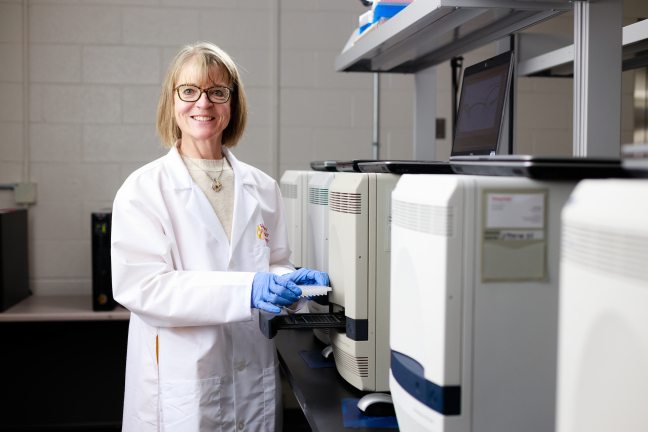
Karen Harmon helped to optimize the processing of COVID-19 tests at the ISU Veterinary Diagnostic Laboratory. This photo was taken while observing safe physical distancing precautions. Photo by Ryan Riley. Larger image.
By Fred Love, News Service
AMES, Iowa – Twenty-four years on the job at the Iowa State University Veterinary Diagnostic Laboratory prepared Karen Harmon for finding every possible efficiency when processing COVID-19 tests.
The VDL has served the animal agriculture industry since 1947, providing comprehensive diagnostic services to livestock producers and veterinarians as they monitor their herds for disease. But last year, the VDL took on a new challenge. When it became clear widescale testing for the virus was going to be an essential step in managing the pandemic, the VDL, which processes upward of 100,000 animal cases every year, took the unprecedented step of opening new lab space and getting certified to process human samples. The lab partnered with the University of Iowa’s State Hygienic Laboratory to expand the state’s testing capacity, and the VDL processed the tests required for the university’s on-campus testing efforts.
The COVID-19 tests depend on polymerase chain reaction technology, a method of amplifying small amounts of DNA to become high enough to detect and identify. And luckily, Dr. Karen Harmon, a clinical associate professor of veterinary diagnostic and production animal medicine with more than two decades working at the VDL, knows plenty about polymerase chain reaction tests. Harmon estimates that the VDL has run more than 4 million such tests since 2005.
The pandemic made every ounce of testing capacity precious, and lab supplies necessary for running the PCR tests grew scarce. So efficiency in processing the tests was essential, Harmon said. Initial Centers for Disease Control and Prevention guidance suggested each PCR test contain three components, with each one requiring its own test. Two of these testing components target separate nucleoproteins that surround the virus. The third component confirms that the sample originated in a human.
“Initially, way back when PCR tests were developed, if you wanted to test for more than one target, it was pretty common to do that in separate tests,” Harmon said. “But as technologies and better reagents were developed, sometimes it’s pretty simple to just combine everything from the two individual tests into one tube and it works very well.”
Harmon found a way to combine all three components of the COVID-19 test into a single test, allowing the laboratory to arrive at the same results faster and more efficiently. Harmon had to optimize the testing conditions and the concentrations of the components. Then the laboratory had to conduct equivalency testing, or comparisons of the results obtained from combined tests with results from individual tests. This ensured the combined tests didn’t sacrifice any accuracy.
The lab eventually arrived at a method for running all three components of the PCR test simultaneously and obtaining the exact same information from processing the three components separately.
Harmon said the lab’s work in running PCR tests for animal samples laid the groundwork.
“This is something that we do all the time for animal testing to streamline and improve efficiency,” she said. “Our clients expect same-day results for many of the samples we receive, so we’ve learned to scale up our efficiency to the point we can test literally thousands of samples a day.”
Quick look
In response to the pandemic, the ISU Veterinary Diagnostic Laboratory took the unprecedented step of opening new lab space and getting certified to process human samples. The lab partnered with the University of Iowa’s State Hygienic Laboratory to expand the state’s testing capacity, and the VDL processed the tests required for the university’s on-campus testing efforts. With two decades of experience running diagnostic tests, Dr. Karen Harmon found a way to improve the efficiency of COVID-19 test processing.
Quote
“Initially, way back when PCR tests were developed, if you wanted to test for more than one target, it was pretty common to do that in separate tests. But as technologies and better reagents were developed, sometimes it’s pretty simple to just combine everything from the two individual tests into one tube and it works very well.”
Karen Harmon, clinical associate professor of veterinary diagnostic and production animal medicine
Read the series
Learn more about ISU’s pandemic response in a collection of stories highlighting some of the hard work, dedication and collaboration across campus.